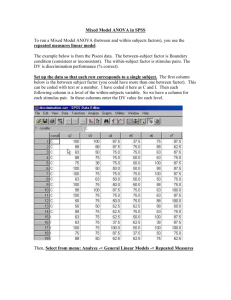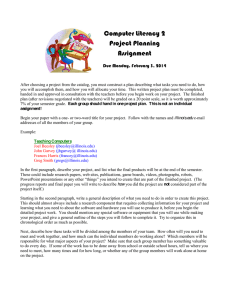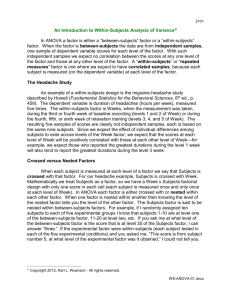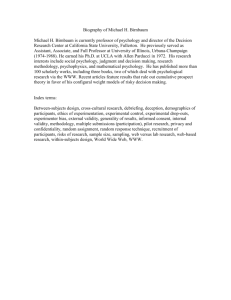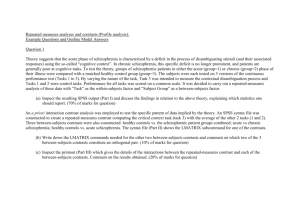An Introduction to the Analysis of Repeated Measures
advertisement
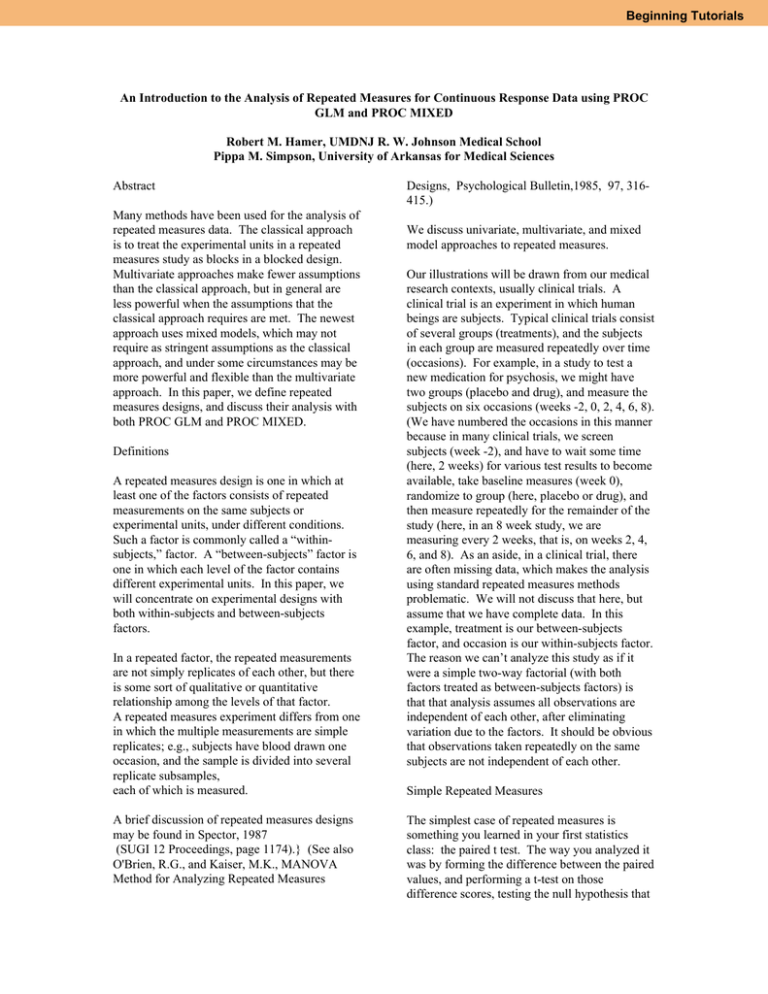
Beginning Tutorials
An Introduction to the Analysis of Repeated Measures for Continuous Response Data using PROC
GLM and PROC MIXED
Robert M. Hamer, UMDNJ R. W. Johnson Medical School
Pippa M. Simpson, University of Arkansas for Medical Sciences
Abstract
Many methods have been used for the analysis of
repeated measures data. The classical approach
is to treat the experimental units in a repeated
measures study as blocks in a blocked design.
Multivariate approaches make fewer assumptions
than the classical approach, but in general are
less powerful when the assumptions that the
classical approach requires are met. The newest
approach uses mixed models, which may not
require as stringent assumptions as the classical
approach, and under some circumstances may be
more powerful and flexible than the multivariate
approach. In this paper, we define repeated
measures designs, and discuss their analysis with
both PROC GLM and PROC MIXED.
Definitions
A repeated measures design is one in which at
least one of the factors consists of repeated
measurements on the same subjects or
experimental units, under different conditions.
Such a factor is commonly called a “withinsubjects,” factor. A “between-subjects” factor is
one in which each level of the factor contains
different experimental units. In this paper, we
will concentrate on experimental designs with
both within-subjects and between-subjects
factors.
In a repeated factor, the repeated measurements
are not simply replicates of each other, but there
is some sort of qualitative or quantitative
relationship among the levels of that factor.
A repeated measures experiment differs from one
in which the multiple measurements are simple
replicates; e.g., subjects have blood drawn one
occasion, and the sample is divided into several
replicate subsamples,
each of which is measured.
A brief discussion of repeated measures designs
may be found in Spector, 1987
(SUGI 12 Proceedings, page 1174).} (See also
O'Brien, R.G., and Kaiser, M.K., MANOVA
Method for Analyzing Repeated Measures
Designs, Psychological Bulletin,1985, 97, 316415.)
We discuss univariate, multivariate, and mixed
model approaches to repeated measures.
Our illustrations will be drawn from our medical
research contexts, usually clinical trials. A
clinical trial is an experiment in which human
beings are subjects. Typical clinical trials consist
of several groups (treatments), and the subjects
in each group are measured repeatedly over time
(occasions). For example, in a study to test a
new medication for psychosis, we might have
two groups (placebo and drug), and measure the
subjects on six occasions (weeks -2, 0, 2, 4, 6, 8).
(We have numbered the occasions in this manner
because in many clinical trials, we screen
subjects (week -2), and have to wait some time
(here, 2 weeks) for various test results to become
available, take baseline measures (week 0),
randomize to group (here, placebo or drug), and
then measure repeatedly for the remainder of the
study (here, in an 8 week study, we are
measuring every 2 weeks, that is, on weeks 2, 4,
6, and 8). As an aside, in a clinical trial, there
are often missing data, which makes the analysis
using standard repeated measures methods
problematic. We will not discuss that here, but
assume that we have complete data. In this
example, treatment is our between-subjects
factor, and occasion is our within-subjects factor.
The reason we can’t analyze this study as if it
were a simple two-way factorial (with both
factors treated as between-subjects factors) is
that that analysis assumes all observations are
independent of each other, after eliminating
variation due to the factors. It should be obvious
that observations taken repeatedly on the same
subjects are not independent of each other.
Simple Repeated Measures
The simplest case of repeated measures is
something you learned in your first statistics
class: the paired t test. The way you analyzed it
was by forming the difference between the paired
values, and performing a t-test on those
difference scores, testing the null hypothesis that
Beginning Tutorials
the population mean of those difference scores
was zero.
Assume you have a single group of subjects (a
sample from a single population), and you have
measured them both before and after some
treatment. You can use a data step to take the
difference between the two measurements:
GDWD VLPSOH
LQSXW VXEMHFW SUH SRVW
GLII SRVWSUH
FDUGV
[…data…]
The SAS code to perform a t test on these
difference scores is:
SURF PHDQV PHDQ VWG VWGHUU W SUW
GDWD VLPSOH
YDU GLII
UXQ FHVDUHDQ
(You could also use PROC UNIVARIATE to
obtain the same test.)
You could obtain the same test in GLM with an
intercept-only model:
SURF JOP GDWD VLPSOHVW
PRGHO GLII WLWOH WWHVW RQ GLIIHUHQFH
VFRUHV
UXQ
Although this is an F-test, rather than a t-test, the
two are functions of each other, and the p-values
are the same.
Finally, you could fit a traditional blocked
model, using the subjects as blocks, and the
repeated measures as dependent variable. This
requires that the data be reshaped such that each
observation consists of a subject code, a variable
indicating whether the observed value was
observed at time 0 or time 1, and the dependent
variable value itself:
SURF JOP GDWD VLPSORQJ
FODVV LG WLPH
PRGHO \ LG WLPH
WLWOH 8QLYDULDWH DSSURDFK RQH
ZLWKLQ IDFWRU GHVLJQ
UXQ
In this analysis, subject id is treated as a blocking
factor.
We could even analyse these data using PROC
MIXED, simply treating it as a fixed effects
blocked design:
SURF PL[HG GDWD VLPSORQJ
FODVV LG WLPH
PRGHO \ LG WLPH
WLWOHO ILW XQL DSSURDFK ZLWK
SURF PL[HG
UXQ
Notice that we have no REPEATED statement
nor RANDOM statement in our invocation of
PROC MIXED. The MODEL statement in
MIXED is used to specify FIXED effects only,
and is thus fitting exactly the same model as is
GLM. (Further, we ignore the issue of whether a
repeated measures analysis is most appropriate
for these data, as opposed to an analysis of
covariance, for example.)
Analyzing repeated measures designs treating
subjects as blocks is necessary to meet the
independence of observations assumption central
to the usual fixed-effects ANOVA that GLM
uses. The usual ANOVA assumes that all
observations are independent of all other
observations (within groups), and if multiple
observations come from the same subject, that is
obviously not true. That is why we cannot
annualize repeated measures designs using the
same methods we would use for factorial designs,
treating the within-subjects factors as if they
were between-subjects factors. We must
somehow fit a model that extracts this
dependence from the errors, and moves it into the
model, thus rendering the errors either
independent, or something enough like
independent that we can handle it properly. The
blocked ANOVA does this.
It turns out that it is not strictly necessary for all
the measurements within a subject to be
independent of each other, in order for ANOVA
to produce appropriate estimates and tests, but
Beginning Tutorials
that they meet a less restrictive condition called
sphericity. Spherically roughly corresponds to a
statement that all correlations among differences
among the occasions are a constant. With only
two levels to the within-subjects factor (two time
points), the sphericity assumption is met by
definition, and we don’t have to worry about it.
If there are more than two time points, that
assumption may be an issue. Thus, in the above
example, with only two time points, sphericity
was not an issue.
If there are more than two time points, sphericity
may be an issue. There are several methods of
handling that: one may (a) perform a test in
which the null hypothesis is that the sphericity
assumption is met, and if it is not, adjust for the
extent to which it is not met, (b) perform the
analysis via a multivariate approach to repeated
measures, which doesn’t make the sphericity
assumption. The multivariate approach is less
powerful when the sphericity assumption is met.
Finally (c), one may use mixed models, which
have the capacity to fit models with a variety of
error covariance matrices, which may include
several patterns of relationships among the
occasions.
More Complex Models – One Between-Subjects
and one Within-Subjects Factor
As stated earlier, we use a clinical trial for our
example, with two groups, placebo and drug (the
between-subjects factor with two levels), and
three occasions (the within-subjects factor with
three levels). We use a within-subjects factor
with three levels (occasions). We chose three
occasions because had we fewer we would not
need to concern ourselves with the sphericity
assumption, and more than three occasions would
not teach us anything we can’t learn with three
occasions.
To analyse these data using the traditional
univariate approach to repeated measures, with
subjects treated as blocks, we could use PROC
GLM:
SURF JOP GDWD QH[WORQJ
FODVV JURXS WLPH LG
PRGHO \\ JURXS LGJURXS WLPH
JURXSWLPH
WHVW K JURXS H LGJURXS
WLWOH 8QLYDULDWH $SSURDFK ZR
&RUUHFWLRQ
UXQ
In this analysis, we have one observation for each
time point within each subject. Since group is
between-subjects, we need a between-subjects
mean square to use in the denominator of the Fstatistics to test the null hypothesis about it. We
construct this F test with the test statement. The
id(group) in the model is subject nested within
group, which is the within-group variation. That
is the appropriate yardstick to use to examine the
between-group variation. The usual residual
error term is the within-subjects variation, which
is the appropriate yardstick to use to examine the
time and group*time effects.
This analysis implicitly assumes sphericity, but
does not examine it. If we wish to perform an
analysis that does not assume sphericity, and we
wish to examine it more closely, we may use the
REPEATED statement in GLM:
SURF JOP GDWD QH[WZLGH
FODVV JURXS
PRGHO \\ JURXS
UHSHDWHG WLPH SULQWH
WLWOH XQLYDULDWH DQG PXOW
DSSURDFK ZLWK UHSHDWHG
VWDWHPHQW
UXQ
The REPEATED statement triggers several
analyses: It produces the univariate approach to
repeated measures that we discussed above; it
produces the multivariate approach to repeated
measures, which does not require the sphericity
assumption. It tests (if we use the PRINTE
option on the REPEATED statement) the
sphericity assumption. Further, it produces two
adjustments to the univariate approach, to allow
us to use a univariate approach but adjust for the
extent to which the sphericity assumption is
violated. Finally, it produces a multivariate
approach to repeated measures, in which the
repeated observations are simply treated as
multiple dependent variables, with contrasts
among them used to produce the time effect and
the group*time interaction. Since dependent
variables in a multivariate ANOVA are allowed
to have any pattern of correlation among them,
Beginning Tutorials
we don’t have to worry whether the sphericity
assumption is met.
Finally, PROC MIXED actually divides the
model into two portions – one for the fixed
effects (in this case, think of that as the betweensubjects factor), and the other for the random
effects (think of that as the within-subjects
factor). The REPEATED statement in MIXED
is a different statement than the REPEATED
statement in GLM, with a different syntax. It is
used in MIXED to specify the variable withinwhich the repeated measures occur. The
between-subjects effects and the within-subjects
effects are each allowed to have their own
covariance matrices, which means that we can fit
a wide range of models to a wide range of data,
without necessarily assuming that the errors for
all observations are independent of the error
terms for all other observations.
To analyze these data with PROC MIXED, we
would use the following code:
SURF PL[HG GDWD QH[WORQJ
FODVV JURXS LG WLPH
PRGHO \\ JURXS WLPH
JURXSWLPH
UHSHDWHG VXEMHFW JURXSLG U
WLWOH 0,;(' ZLWK RQH EHWZHHQ
RQH ZLWKLQ 5(3($7(' VWPW
UXQ
Note that the MODEL statement contains the
effects in which we are interested, the group
effect, the time effect, and the group by time
interaction. The REPEATED statement is used
to tell MIXED that there is some effect that
occurs within subject within group. MIXED
examines the values of each variable for each
subject within each group, and realizes that the
variable time occurs multiple times. It thus
realizes that time (and hence the group*time
interaction) are within-subject factors.
Finally, another advantage of MIXED is the
ability to fit models in which the error between
subjects are allowed to be correlated. You can
fit various patterned covariance matrices, but one
of particular interest to repeated measures
designs is a compound symmetric covariance
matrix. This is very close to the sphericity
condition we discussed earlier. Specifying
TYPE=CS in the REPEATED statement forces
MIXED to fit the data to a model with a
compound symmetric covariance matrix:
SURF PL[HG GDWD QH[WORQJ
FODVV JURXS LG WLPH
PRGHO \\ JURXS WLPH
JURXSWLPH
UHSHDWHG W\SH FV
VXEMHFW JURXSLG U
WLWOH 0,;(' ZLWK RQH EHWZHHQ
RQH ZLWKLQ 5(3($7(' VWPW DQG
7<3( &6
UXQ
If we are willing to assume compound symmetry,
it makes sense to model it. MIXED is capable of
fitting a wide variety of covariance structures.
In summary, we have used GLM and MIXED
with several types of repeated measures designs,
and compared and contrasted them. We have
discussed some particular advantages to the use
of the MIXED procedure.
Contact Information:
Robert M. Hamer, Ph.D. hamer@umdnj.edu
Department of Psychiatry
UMDNJ-RWJMS
675 Hoes Lane
Piscataway, NJ 08854
Pippa M. Simpson, Ph.D.
Arkansas Children’s Hospital / UAMS
